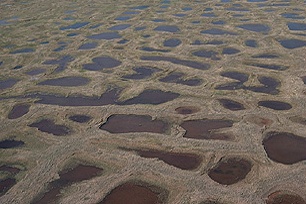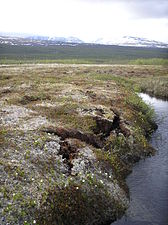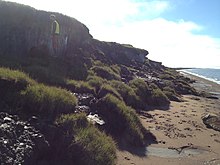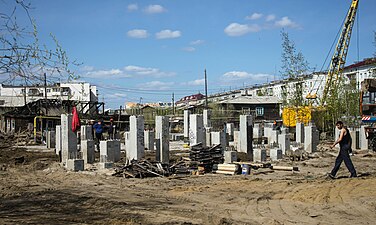Permafrost: Wikipedia
Permafrost
From Wikipedia, the free encyclopedia
This article is about frozen ground. For other uses, see Permafrost (disambiguation).
| Permafrost | |
|---|---|
 |
|
| Map showing extent and types of permafrost in the Northern Hemisphere | |
| Used in: | International Permafrost Association |
| Climate: | High latitudes, alpine regions |
| Wikinews has related news: Scientists warn thawing Siberia may trigger global meltdown |
Slope failure of permafrost soil, revealing ice lenses.
A global temperature rise of 1.5 °C (2.7 °F) above current levels would be enough to start the thawing of permafrost in Siberia, according to one group of scientists.[3]
Contents
Extent and manifestations of permafrost
The red dotted-to-solid line depicts the average temperature profile
with depth of soil in a permafrost region. The trumpet-shaped lines at
the top show seasonal maximum and minimum temperatures in the "active
layer", which commences at the depth where the maximum annual
temperature intersects 0° C. The active layer is seasonally frozen. The
middle zone is permanently frozen as "permafrost". And the bottom layer
is where the geothermal temperature is above freezing. Note the
importance of the vertical 0° C line: It denotes the bottom of the
active layer in the seasonally variable temperature zone and the bottom
limit of permafrost as the temperature increases with depth.
The extent of permafrost varies with the climate. Today, a considerable area of the Arctic is covered by permafrost (including discontinuous permafrost). Overlying permafrost is a thin active layer that seasonally thaws during the summer. Plant life can be supported only within the active layer since growth can occur only in soil that is fully thawed for some part of the year. Thickness of the active layer varies by year and location, but is typically 0.6–4 m (2.0–13.1 ft) thick. In areas of continuous permafrost and harsh winters, the depth of the permafrost can be as much as 1,493 m (4,898 ft) in the northern Lena and Yana River basins in Siberia.[8] Permafrost can also store carbon, both as peat and as methane. Work investigating the permafrost carbon pool size estimates that 1400–1700 Gt of carbon is stored in the northern circumpolar permafrost region.[9] While a recent study that includes stores of the Tibetan Plateau, estimates total carbon pools in the permafrost of the Northern Hemisphere to be 1832 Gt.[10] This large carbon pool represents more carbon than currently exists in all living things.
Excavating ice-rich permafrost with a jackhammer in Alaska.
Massive ground ice
When the ice content of a permafrost exceeds 250 percent (ice to dry soil on a weight basis) it is classified as massive ice. Massive ice bodies can range in composition, in every conceivable gradation from icy mud to pure ice. Massive icy beds have a minimum thickness of at least 2 m, a short diameter of at least 10 m (Mackay, p. 223, 1973). First recorded North American observations were by European scientists at Canning River, Alaska in 1919 (French, 2007). Russian literature provides an earlier date of 1735 and 1739 during the Great North Expedition by P. Lassinius and Kh. P. Leptev, respectively (Shumskiy and Vtyurin, 1966).Two major categories of massive ground ice have been identified including buried surface ice and intrasedimental (Mackay,1989), or constitutional (Shumskiy and Vtyurin, 1966), ice. Buried surface ice includes snow, frozen lake or sea ice, aufies river ice and, probably the most prevalent, buried glacial ice (Astakhov, 1986; Kaplanskaya and Tarnogradskiy, 1986; Astakhov and Isayeva, 1988; French, 1990; Lacelle et al., 2009). Intrasedimental ice forms by in-place freezing of subterranean waters and is dominated by segregational ice which results from the crystallizational differentiation taking place during the freezing of wet sediments, accompanied by water migrating to the freezing front (Shumskiy and Vtyurin, 1966, p 109). Intrasedimental or constitutional ice has been widely observed and studied across Canada and also includes intrusive and injection ice (Shumskiy and Vtyurin, 1966; Mackay, 1971, 1973, 1989; Harry et al., 1988; French and Harry, 1990; Pollard, 1990; Mackay and Dallimore, 1992; French, 1998; Pollard, 1991; Murton et al., 2004). Russian investigators including I.A. Lopatin, B. Khegbomov, S. Taber and G. Beskow formulated the original theories for ice inclusions in freezing soils (Shumskiy and Vtyurin, 1966). In addition, but within a separate category of ground ice, ice wedges are a visually spectacular type of ground ice that produce recognizable patterned ground or tundra polygons. Younger than the surrounding substrate, ice wedges are distinctive massive ice features first investigated by E. Leffingwell in 1919 by Galwitz and Popov (Popov, 1962; Shumskiy and Vtyurin, 1966; Pewe, 1966b; French et al., 1982; Michel, 1990).
Continuous and discontinuous permafrost
Permafrost typically forms in any climate where the mean annual air temperature is less than the freezing point of water. Exceptions are found in moist-wintered forest climates, such as in Northern Scandinavia and the North-Eastern part of European Russia west of the Urals, where snow acts as an insulating blanket. Glaciated areas may be exceptions. Since all glaciers are warmed at their base by geothermal heat, temperate glaciers, which are near the pressure-melting point throughout, may have liquid water at the interface with the ground and are therefore free of underlying permafrost.[11]Typically, the below-ground temperature varies less from season to season than the air temperature, with temperatures tending to increase with depth. Thus, if the mean annual air temperature is only slightly below 0 °C (32 °F), permafrost will form only in spots that are sheltered—usually with a northerly aspect. This creates what is known as discontinuous permafrost. Usually, permafrost will remain discontinuous in a climate where the mean annual soil surface temperature is between −5 and 0 °C (23 and 32 °F). In the moist-wintered areas mentioned before, there may not be even discontinuous permafrost down to −2 °C (28 °F). Discontinuous permafrost is often further divided into extensive discontinuous permafrost, where permafrost covers between 50 and 90 percent of the landscape and is usually found in areas with mean annual temperatures between −2 and −4 °C (28 and 25 °F), and sporadic permafrost, where permafrost cover is less than 50 percent of the landscape and typically occurs at mean annual temperatures between 0 and −2 °C (32 and 28 °F).[citation needed] In soil science, the sporadic permafrost zone is abbreviated SPZ and the extensive discontinuous permafrost zone DPZ.[12]
Exceptions occur in un-glaciated Siberia and Alaska where the present depth of permafrost is a relic of climatic conditions during glacial ages where winters were up to 11 °C (20 °F) colder than those of today. At mean annual soil surface temperatures below −5 °C (23 °F) the influence of aspect can never be sufficient to thaw permafrost and a zone of continuous permafrost (abbreviated to CPZ) forms. "Fossil" cold anomalies in the Geothermal gradient in areas where deep permafrost developed during the Pleistocene persist down to several hundred metres. The Suwałki cold anomaly in Poland led to the recognition that similar thermal disturbances related to Pleistocene-Holocene climatic changes are recorded in boreholes throughout Poland.[13]
A line of continuous permafrost in the Northern Hemisphere[14] represents the most southerly border where land is covered by continuous permafrost or glacial ice. The line of continuous permafrost varies around the world northward or southward due to regional climatic changes. In the southern hemisphere, most of the equivalent line would fall within the Southern Ocean if there were land there. Most of the Antarctic continent is overlain by glaciers.
In the Andes along the Atacama Desert permafrost extends down to an altitude of 4,400 metres (14,400 ft) and is continuous above 5,600 metres (18,400 ft).
Subsea permafrost
Subsea permafrost occurs beneath the seabed and exists in the continental shelves of the polar regions.[4] These areas formed during the last ice age, when a larger portion of earth's water was bound up in ice sheets on land and when sea levels were low. As the ice sheets melted to again become seawater, the permafrost became submerged shelves under relatively warm and salty boundary conditions, compared to surface permafrost. Therefore, subsea permafrost exists in conditions that lead to its diminishment. According to Osterkamp, subsea permafrost is a factor in the "design, construction, and operation of coastal facilities, structures founded on the seabed, artificial islands, sub-sea pipelines, and wells drilled for exploration and production."[15] It also contains gas hydrates in places, which are both a "potential abundant source of energy", but also may destabilize, as subsea permafrost warms and thaws, producing large amounts of methane gas, which is a potent green-house gas.[15][16]Time to form deep permafrost
| Time (yr) | Permafrost depth |
|---|---|
| 1 | 4.44 m (14.6 ft) |
| 350 | 79.9 m (262 ft) |
| 3,500 | 219.3 m (719 ft) |
| 35,000 | 461.4 m (1,514 ft) |
| 100,000 | 567.8 m (1,863 ft) |
| 225,000 | 626.5 m (2,055 ft) |
| 775,000 | 687.7 m (2,256 ft) |
Carbon cycle in permafrost
The permafrost carbon cycle (Arctic Carbon Cycle) deals with the transfer of carbon from permafrost soils to terrestrial vegetation and microbes, to the atmosphere, back to vegetation, and finally back to permafrost soils through burial and sedimentation due to cryogenic processes. Some of this carbon is transferred to the ocean and other portions of the globe through the global carbon cycle. The cycle includes the exchange of carbon dioxide and methane between terrestrial components and the atmosphere, as well as the transfer of carbon between land and water as methane, dissolved organic carbon, dissolved inorganic carbon, particulate inorganic carbon and particulate organic carbon.[19]Landforms
Permafrost processes manifest themselves in large-scale land forms, such as palsas and pingos[20] and smaller-scale phenomena, such as patterned ground found in arctic, periglacial and alpine areas.[21]-
A group of palsas, as seen from above, formed by the growth of ice lenses.
-
-
Stone rings on Spitsbergen
-
Ice wedges seen from top
Global climate change effects on permafrost extent
See also: Climate change in the Arctic and Arctic methane release
Historical changes in permafrost
Recently thawed Arctic permafrost and coastal erosion on the Beaufort Sea, Arctic Ocean, near Point Lonely, Alaska. Photo Taken in August, 2013
According to IPCC Fifth Assessment Report there is high confidence that permafrost temperatures have increased in most regions since the early 1980s. Observed warming was up to 3°C in parts of Northern Alaska (early 1980s to mid-2000s) and up to 2°C in parts of the Russian European North (1971–2010).[27] In Yukon, the zone of continuous permafrost might have moved 100 kilometres (62 mi) poleward since 1899, but accurate records only go back 30 years. It is thought that permafrost thawing could exacerbate global warming by releasing methane and other hydrocarbons, which are powerful greenhouse gases.[28][29][30] It also could encourage erosion because permafrost lends stability to barren Arctic slopes.
Predicted rate of temperature change in Arctic
Arctic temperatures are expected to increase at roughly twice the global rate.[31] The Intergovernmental Panel on Climate Change (IPCC) will in their fifth report establish scenarios for the future, where the temperature in the Arctic will rise between 1.5 and 2.5°C by 2040 and with 2 to 7.5°C by 2100. Estimates vary on how many tons of greenhouse gases are emitted from thawed permafrost soils. One estimate suggests that 110-231 billion tons of CO2 equivalents (about half from carbon dioxide and the other half from methane) will be emitted by 2040, and 850-1400 billion tons by 2100.[32] This corresponds to an average annual emission rate of 4-8 billion tons of CO2 equivalents in the period 2011-2040 and annually 10-16 billion tons of CO2 equivalents in the period 2011-2100 as a result of thawing permafrost. For comparison, the anthropogenic emission of all greenhouse gases in 2010 is approximately 48 billion tons of CO2 equivalents.[33] Release of greenhouse gases from thawed permafrost to the atmosphere may increase global warming.Permafrost thaw versus melt
See also: Thermokarst
Permafrost thaw ponds on peatland in Hudson Bay, Canada in 2008.[34]
By definition, permafrost is ground that remains frozen for two or more years. Since frozen soil, including permafrost, comprises a large percentage of substrate materials other than ice, it thaws rather than melts even as any ice content melts.[35] An analogy is when a freezer door is left open, although the ice in the freezer may change phase to a liquid, the food solids will not experience a phase change. In aggregate, the food thaws but does not melt. Melting implies the phase change of all solids to liquid. One visible sign of permafrost degradation is the random displacement of trees from their vertical orientation in permafrost areas.[36][37]
Ecological consequences
World-wide, permafrost contains 1700 billion tons of organic material equaling almost half of all organic material in all soils.[6] This pool was built up over thousands of years and is only slowly degraded under the cold conditions in the Arctic. The amount of carbon sequestered in permafrost is four times the carbon that has been released to the atmosphere due to human activities in modern time.[32] One manifestation of this is yedoma, which is an organic-rich (about 2% carbon by mass) Pleistocene-age loess permafrost with ice content of 50–90% by volume.[38]Formation of permafrost has significant consequences for ecological systems, primarily due to constraints imposed upon rooting zones, but also due to limitations on den and burrow geometries for fauna requiring subsurface homes. Secondary effects impact species dependent on plants and animals whose habitat is constrained by the permafrost. One of the most widespread examples is the dominance of Black Spruce in extensive permafrost areas, since this species can tolerate rooting pattern constrained to the near surface.[39]
One gram of soil from the active layer may include more than one billion bacteria cells. If placed along each other, bacteria from one kilogram of active layer soil will form a 1000 km long chain. The number of bacteria in permafrost soil varies widely, typically from 1 to 1000 million per gram of soil.[40] Most of these bacteria and fungi in permafrost soil can not be cultured in the laboratory, but the identity of the microorganisms can be revealed by DNA-based techniques.
Should a substantial amount of the carbon enter the atmosphere, it would accelerate planetary warming. A significant proportion will emerge as methane, which is produced when the breakdown occurs in lakes or wetlands. Although it does not remain in the atmosphere for long, methane traps more of the sun’s heat. The Arctic region is one of the many natural sources of the greenhouse gas methane.[41] Global warming accelerates its release, due to both release of methane from existing stores, and from methanogenesis in rotting biomass.[42] Large quantities of methane are stored in the Arctic in natural gas deposits, permafrost, and as submarine clathrates. Permafrost and clathrates degrade on warming, thus large releases of methane from these sources may arise as a result of global warming.[43][44] Other sources of methane include submarine taliks, river transport, ice complex retreat, submarine permafrost and decaying gas hydrate deposits.[45] Preliminary computer analyses suggest that permafrost could produce carbon equal to 15 percent or so of today’s emissions from human activities.[46]
Climate Change and Slope Stability
Over the past century, an increasing number of alpine rock slope failure events in mountain ranges around the world have been recorded. It is expected that the high number of structural failures is due to permafrost thawing, which is thought to be linked to climate change. In mountain ranges, much of the structural stability can be attributed to glaciers and permafrost. As climate warms, permafrost thaws, which results in a less stable mountain structure, and ultimately more slope failures.[47]Other permafrost issues
The International Permafrost Association (IPA) is an integrator of issues, regarding permafrost. It convenes International Permafrost Conferences, undertake special projects such as preparing databases, maps, bibliographies, and glossaries, and coordinate international field programmes and networks. Among others issues addressed by the IPA and other organizations are: Problems for construction on permafrost, owing to the change of soil properties of ground on which structures are placed and the biological processes in permafrost, e.g. the preservation of organisms frozen in situ.Construction on permafrost
Building on permafrost is difficult because the heat of the building (or pipeline) can thaw the permafrost and destabilize the structure. Three common solutions include: using foundations on wood piles; building on a thick gravel pad (usually 1–2 metres/3.3–6.6 feet thick); or using anhydrous ammonia heat pipes.[48] The Trans-Alaska Pipeline System uses heat pipes built into vertical supports to prevent the pipeline from sinking and the Qingzang railway in Tibet employs a variety of methods to keep the ground cool, both in areas with frost-susceptible soil. Permafrost may necessitate special enclosures for buried utilities, called "utilidors".The Permafrost Research Institute in Yakutsk, found that the sinking of large buildings into the ground can be prevented by using pile foundations extending down to 15 metres (49 ft) or more. At this depth the temperature does not change with the seasons, remaining at about −5 °C (23 °F).
-
Heat pipes in vertical supports maintain a frozen bulb around portions of the Trans-Alaska Pipeline that are at risk of thawing.
-
Pile foundations in Yakutsk, a city underlain with continuous permafrost.
Revival of organisms preserved in permafrost
In 2012, Russian researchers have proved that permafrost can serve as a natural depository for ancient life forms by the reviving of Silene stenophylla from a tissue as the oldest plant ever to be generated from a burrow in the Siberian permafrost for over 30,000 years. The plant is fertile, producing white flowers and viable seeds. The study has demonstrated that tissue can survive ice preservation for tens of thousands of years.[49]References
- "Russians revive Ice Age flower from frozen burrow". February 21, 2012.
- Trombotto, Dario. 2002. "Inventory of fossil cryogenic forms and structures in Patagonia and the mountains of Argentina beyond the Andes". South African Journal of Science, 98: 171-180, Review Articles, Pretoria, Sudáfrica.
External links
| Wikimedia Commons has media related to Permafrost. |
|
||||||||||||||||||||||||||||
|
Here and there, roadside utility poles destabilized by the melting tilt at crazy angles. So do trees, creating a phenomenon known as drunken forest.
…caused what the locals call "drunken forests," the trees tilting and leaning…


















No comments:
Post a Comment